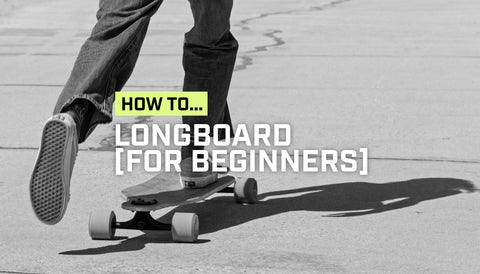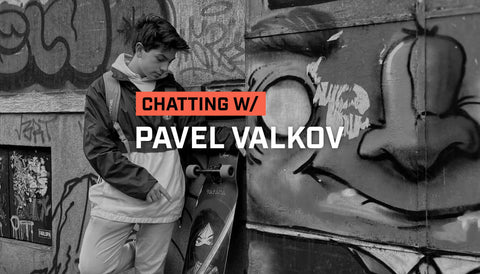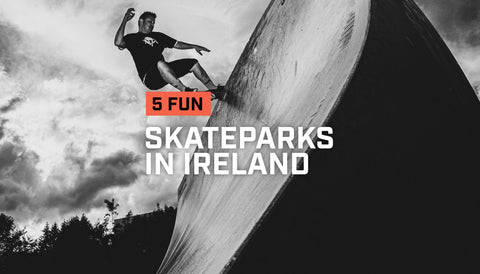If you’re looking to learn how to longboard, you’re in the right place! We’re going to cover everything you need to know to get skating within the next hour, EVEN if you are a complete beginner longboarder and have never touched a board before in your life.
Just a quick note: what we are going to teach you below applies to both longboarding and skateboarding, so whichever ride style you choose, we have you covered.
A second note: this is a basic guide for beginners wanting to get on a board. If you are wanting to learn Freeride, Longboard Dance, freestyle or other forms of longboarding, you will need to master these basics first.
Safety Gear First
True with anything in life, you’re going to fail some of the time. Being brand new to the world of skateboarding, here’s our list of protective gear to get before setting foot on your board:

A helmet - Mandatory
Protect ya neck (and head) like Wu-Tang would expect. We recommend a full cut helmet as it protects your head and sides of the face, should you fall. If you don’t want to go that route, just make sure your helmet is from a reputable brand that has a CE, ASTM or CPSC certification, otherwise you risk finding out much too late that your helmet provided little more protection than not wearing one.
Also, do not buy second hand helmets. Two reasons: 1. The inner shell (the part that protects you) deteriorate over time and you’ll have no way of knowing how old the helmet is. 2. Helmets are pretty much useless once they have taken a hit. Even the smallest impact that might not show on the outside but could have weekend the padding on the inside, rendering the helmet useless.
Knee Pads - Recommended
Number two on our list, get yourself some decent knee pads like these G-Form X3 Knee Pads. G-Form’s flex with the knee and are much more subtle and comfortable than the massive pads you’ve seen in skate videos.
Elbow Pads - Recommended
As with the above, we like G-Form Elbow Pads for the comfortability aspect. They keep your elbows fresh and mobile.
Slide Gloves - Recommended if you’re wanting to learn to slide
Slide gloves are purpose built gloves with velcro pads on to attach your slide pucks. What are slide pucks? They’re UHMW plastic blocks that allow you to get that hand down on the ground as you slide.
——-
Ok, now we have the safety briefing out the way, let’s get to the fun stuff!
Choosing the right longboard to start on
Take a look at our guide to types of skateboards, or scroll on for a few recommendations.
Choosing a spot to learn
Before you’re cruising the bike lane, you’re going to need to find somewhere with no traffic that is pretty much flat, like an empty parking lot.
Finding your stance - Regular vs Goofy
The easiest way to tell if you’re going to ride regular or goofy is just by stepping onto the board without thinking. If you naturally put your left foot at the front of the board*, you’re going to ride regular. If you naturally put your right foot at the front of the board, you’re riding goofy.
*In this case the ‘front of the board’ is the end of the board which would be going forward.

Body positioning & Balance
The front foot is going to provide all of your stability. The front foot will sit directly behind the front truck at an angle. Your back foot should be placed wherever feels comfortable for you, but is usually shoulder-width apart.
One set up, you’ll need to keep your weight forward and knees bent in order to keep your balance. The lower you are on the board, the lower your center of gravity and therefore the easier you’ll find it to balance.
The other thing to keep in mind is that your body will naturally stiffen up until you get used to riding your longboard. Try to keep your limbs loose and relaxed so that you can use your arms to balance and move with the flow of the board.

Pushing off - Mongo vs Regular
Once you’ve figured out your stance and nailed the body positioning, you’re going to want to actually get rolling. The last thing to note is that there are two styles of pushing: Regular & Mongo.
Regular Push - Pushing with your back foot while your front foot is on the deck.
Mongo Push - Pushing with your front foot while your back foot is on the deck. Avoid this as its awkward to push this way, and you look like a loser... (joking, but avoid this)
How to stop on a longboard!
The easiest way to stop (or slow down) is by foot braking! Foot breaking allows you to slow down and/or stop the board completely by sliding your back foot along the ground.
How to foot brake:
With the board static on a very slight incline, place your front foot so that it is facing forward, and your back foot so that it is on the ground next to the board. Lift your back foot (the one that is on the ground) off the ground very slightly until you start to roll forwards, then lower you back foot back down, heel first, to slow down and stop. The more pressure you apply to the ground the faster you will stop. Essentially the aim of the game is to use your heel to control the decrease in speed.
Note: this will wear down your shoes!
Stepping on your longboard for the first time
Time to get rolling!
Start on a flat surface, with your front foot just behind the truck bolts, lean forward slightly, with a bent knee, and push off with your back foot. Once you start rolling forwards, pick up your back foot and place it on the deck facing the edge of the deck (see body positioning section above if you need help), then spin your front foot on the ball of your foot so that it joins your back foot in facing the edge of the deck.
Once rolling, use your foot brake to slow your speed and come to stop.
The aim here is not to try to tackle high speeds, but get a steady roll where you can practice: 1. Your push off, 2. your foot and body positioning & 3. your foot braking.
Turning & Carving & controlling your speed
Next, you are going to want to turn. Sharp turns are known as carving and you can use these to control the speed of the board, and even pump to generate more speed. Think snowboarding vs surfing (turning vs carving).
Ok, to turn your longboard, follow the steps above to get rolling on a flat surface first, then, once your feet are both facing the outer edge of the deck, shift your body weight by rolling your ankle toward your toes (toeside) or heel (heelside). By shifting body weight to the toes or heels, the board and trucks will start to turn underneath you. Always keep your body loosey goosey with your knees slightly bent. The lower you are to the ground the easier to balance.
Make sure to look where you are wanting to go and lead with your shoulder when turning - ie. If you want to turn left, your shoulder points left. If you want to go right, your shoulder points right, guiding you through the turn.
Pro Tip: Set up cones (or whatever you have available) to create a slalom course to practice turning and carving.
One other thing to mention here is that turning and carving will feel very different depending on the type of trucks you have on your set up. Your longboard will likely come with reverse kingpin (RKP) trucks which will turn much more freely than standard traditional Kingpin (TKP) trucks that you would find on a regular skateboard or some mini cruisers like our Fireball Artist Mini Cruiser Series.

Turning with a kicktail
If you have a board such as the Fireball Mini Cruiser it has an upturned tail, known as a kicktail. You can use this for ollies and tricks, but also to turn to skateboard.
To 'kick turn’ turn using your kicktail, place your back foot on the kicktail and shift some of your weight onto it so that the front wheels lift up slightly. While doing this use your shoulder to point you in the direction you wish to go.
A note on falling
You are going to fall. Get used to falling (safely) and learn to love it.
Next steps:
If you’ve mastered the basics, congratulations, you are officially a skater, ready to learn the in’s and out’s of whatever longboard discipline you’re interested in.
If you’re looking to commute or just skate around town, these basics will have you covered.
If you are looking to get into downhill longboarding or freeride, we’d recommend checking out some starter tutorials on youtube.
If you are looking to dance or learn some freestyle tricks, here are 5 easy longboard tricks to learn today.
Recommended Beginner Longboards
We made this guide to help people get on their feet with longboarding, not to sell boards. Without seeming too biased (we are a brand after all!), here are a few boards we would recommend checking out if you have not already got a board. Just to note, there is really no ‘best longboard’ but more a best longboard for what you want to do.
We aren’t going to sell you on these, but just provide some of our recommendations based on what you might want to do. Hit each link and learn more about the picks:
-
Best Budget Longboard - The Sector 9 Pintail ($139.95)
-
Best Overall Longboard - Landyachtz Drop Through Seeker ($219.95)
-
Best Mini Cruiser Longboard - Fireball Artist Series ($159.95)
A good rule of thumb: look to spend around $150-220 on your board. This will ensure you get decent components that will make the longboarding experience as fun as possible. We would have to recommend avoiding the ‘Amazon brands’ as these tend to feature crappy components that you’ll end up replacing.
Also, most real skate companies have comprehensive guarantees, like our lifetime Beast Guarantee. If in doubt, look for a solid guarantee that gives you peace of mind.
Wrapping Up
That about covers this beginners guide to longboarding. If you’ve found it helpful, are stuck on anything or want us to cover another topic like this, let us know in the comments below :)



